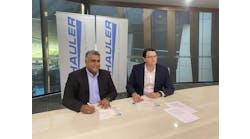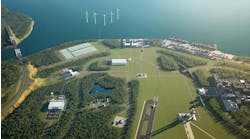"Simatic RTLS and its tags, anchors and gateways can provide precise, centimeter-level tracking down to 20 cm on the plant floor," says Michael Metzler, sales director, Simatic RTLS, Siemens
"Where is it?" That simple question now has a boatload of new answers thanks to the emergence of Siemens Simatic Real-Time Locating System (RTLS), which is a comprehensive platform and infrastructure for seamlessly locating relevant objects and people all the way through digital factories and their value chains."Everyone is talking about using digital twin simulations and virtualization for flexible manufacturing, but how do digital twin applications know how to find what they're looking for in the factories of the future where everything is in motion?" asks Michael Metzler, sales director for Simatic RTLS at Siemens. "Simatic RTLS is the answer because with its network anchors and gateways it can provide precise, centimeter-level tracking down to 20-30 cm on the plant floor."
Michael Metzler, Nicole Lauther, head of business development for RTLS at Siemens USA, and Mark Schlander, vice president of sales and alliances at Guardhat, presented "Real-time locating systems" on the second day of Siemens Automation Summit 2018 on June 27 in Marco Island, Fla.
Siemens enhanced real-time locating initiative was aided by its acquisition four months ago of Agilion, which has more than 145 RTLS installations based on its ultra-wideband (UWB) and 2.4GHz, hybrid-radio technology in industrial, logistics and public transport applications worldwide.
Tracking and tracing
Simatic RTLS consists of three main elements:
- Hardware infrastructure with active transponders mounted on objects that send signals at defined intervals, while at least four anchors collect signals, record locations, bundle and time-stamp data, and transmit it via a gateway to the locating server.
- Locating Manager software that calculates the real-time position of the transponders, sends data to higher-level systems, and also makes it possible to define configurable events via a rule engine.
- IT integration that makes sure locating information and events are flexibly transmitted to higher-level systems.
Lauther added these capabilities allow Simatic RTLS to aid production and intra-logistics in smart manufacturing applications; enable people tracking for service, maintenance and access control functions; and track vehicles in public transport, fleet management, access control situations as well as inbound and outbound logistics.
"Users can monitor work and production in progress, and use precise documentation, traceability and other detailed information to optimize their processes," added Lauther. "Simatic RTLS can also track tools with transponders embedded in items like screwdrivers, and track applied torque and angles at which tools were used. This is accomplished with precise localization within centimeters, zone-controlled control of tools based on flexible geo-fencing, and the ability to document production steps automatically. Also, RTLS provides container locating with status information to optimize material flows, deliver warehouse stock data in real time, and eliminate losses and formerly time-consuming searches."
Hats off to Guardhat
In conjunction with its recent acquisition, Siemens RTLS program is also working with one of Agilion's customers, Guardhat, which has developed a hardhat that's also a fully functional, patent-protected, IIoT-enabled, industrial wearable system—or “smart hardhat ecosystem.” It uses sensor-based and wireless technologies, along with big data, to protect and empower construction, warehouse, utility and industrial workers in heavy manufacturing industries like petroleum, chemicals, steel and mining.
Schlander stated that Guardhat enables users and the enterprise to:
- Precisely locate workers in a 3D space in less than 1 second;
- Communicate directly between individual, teams and the enterprise;
- Understand the environments workers are facing in real-time; and
- Make workplaces enterprise-transparent by gathering, analyzing and acting on data before, during and after events.
In addition, Guardhat is a modular, smart hardhat, as well as a wearable, IoT device that provides sensing, audio/video communication, a variety of data communication capabilities, and local intelligence that consists of local computing with a built-in, complex events, safety-processor engine. The hardhat interacts with a backend safety control center to monitor workers and their environment in real-time, and alert them in real-time, too. Guardhat can operate in autonomous and network-connected mode, and it has a 10-12 hour rechargeable battery, depending on usage, and can add swappable batteries as needed.
The hardhat's tag provides RTLS localization in full 3D by using the same mix of multiple location technologies and Guardhat’s custom RTLS software to provide high precision, sub-meter location in real-time.
"Guardhat can use 2.4 GHz when two-meter accuracy is needed, and it won't interfere with other wireless networks. Or, it can use 3-7 GHz UWB for 20-cm accuracy by communicating with anchors and triangulating," said Schlander.
Schlander added that data from Simatic RTLS can also help users when they're designing projects. For example, it can help users decide how to place equipment in work areas by showing existing pathways and examining if better alternatives are available. "RTLS can help whenever users interact with devices and where they need to be," he added.
“With Simatic RTLS’ real-time locating capabilities, we can offer our customers maximum flexibility in production and logistics and the ability to respond more swiftly to changing markets,” explained Lauther. “We're excited about RTLS’ possibilities throughout the entire digital enterprise, from processing through final assembly to delivery. The real-time data that can be extracted provides real added value.”





